How to Identify Rare Coins: Your Ultimate Checklist
Posted onStumbling upon a potentially rare coin unexpectedly can be thrilling for collectors. Nevertheless, discerning rarity is no easy feat. This determination hinges on various factors that necessitate going beyond surface assessment, prompting a nuanced exploration of the coin’s characteristics. This article aims to answer the question “How do you find out if you have a rare coin?”, focusing on:
- Signs for spotting rare coins.
- Illustrative cases of rare coin identification.
- Tips for owners of rare coins.
Watch this video for more expert advice on spotting rare coins:
How to spot rare coins: 10 surefire signs
If you believe you’ve come across a rare coin, there are various clues that can help confirm this. These fundamental signs serve as an excellent starting point for recognizing numismatic rarities.
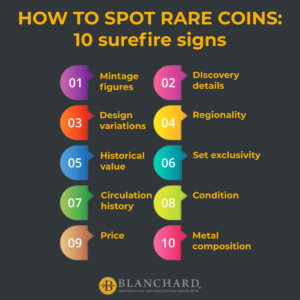
1. Check mintage figures to identify rare coins.
Checking mintage figures is a crucial step in identifying rare coins. Mintage refers to the number of coins produced during a specific time frame and at a particular mint.
Typically, coins with limited mintage due to historical events, errors in production, or special commemorations are likely to be more sought after by collectors. Numismatists looking to discern the scarcity of a coin by researching mintage data should be attentive to variations in mintage figures across different years and minting locations, as even a small discrepancy can significantly impact a coin’s rarity.
Exploring what mintage makes a coin rare becomes essential in the pursuit of understanding the factors that contribute to a coin’s desirability among collectors. To access mintage information, collectors can consult reputable numismatic resources, official mint reports, or online databases dedicated to coin mintage figures.
To illustrate this point, consider this coin, exemplifying the intrinsic connection between a limited mintage of 3,942 and collector allure:
1884 Indian Head Cent PCGS PR67 Red Brown CAC
- Metal: Bronze
- Year: 1884
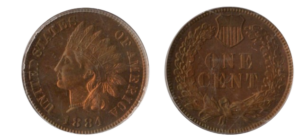
2. Design variations and anomalies are key for rare coin identification.
Careful examination of design variations and anomalies is paramount when figuring out how to tell if a coin is rare. Design evolution in coins is shaped by changes in minting processes, advancements in technology, and shifts in artistic preferences, among other factors. Anomalies occur when unexpected errors like double strikes, off-center minting, or die cracks manifest.
When present, these variations and anomalies contribute significantly to a coin’s rarity, enhancing its uniqueness and desirability among collectors. To identify these distinctions, utilize reputable reference numismatic materials, or consult with experienced professionals.
3. Historical significance is integral to what makes coins rare.
A coin’s historical significance is another factor serving as a “rare coin identifier”. Rare coins often derive their scarcity from the circumstances surrounding their production or the historical context they encapsulate.
Coins commemorating significant events, personalities, or periods in history often hold a special allure for collectors. Moreover, coins minted during pivotal moments, such as war times or economic crises, tend to be scarcer due to limited production or subsequent withdrawals from circulation.
Researching the historical context of a coin, including its origin, purpose, and any associated stories, enriches a collector’s understanding of its rarity and can help determine its worth and importance within numismatic circles.
A case is this ancient Roman coin, a tangible artifact that vividly encapsulates the cultural, political, and economic nuances of its era:
Twelve Caesars – Julius Caesar
- Metal: Silver
- Year: c. 46 – 45 BC
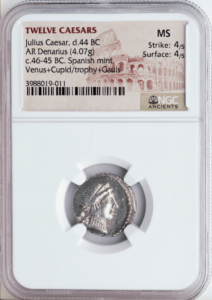
4. A coin’s circulation history is a pivotal factor in how to identify rare coins.
Identifying rare coins requires a consideration of their circulation history. Coins with limited circulation, perhaps due to limited issuance or geographic distribution, are often deemed rarer by collectors. Additionally, understanding the patterns of coin withdrawals from circulation, whether due to economic changes or the introduction of new currency, helps collectors assess the availability of specific coins.
In the process of learning how to spot a rare coin, numismatists must delve into the historical context of circulation, tracking the coin’s trajectory from mint to hands of collectors. In this way, they can gain insights into the scarcity of well-preserved coins and recognize the impact of circulation on a coin’s overall rarity.
5. High prices serve as a reliable rare coin value checker.
The principle of supply and demand is particularly evident in the realm of rare coins, where heightened collector interest and limited availability drive prices upward. This means that high prices in the numismatic market serve as a reliable indicator when checking the rarity and value of coins. A coin’s market value often reflects its scarcity, historical significance, and overall desirability among collectors.
Collectors and investors alike frequently use auction results, price guides, and sales records to gauge the rarity of a coin. In the digital age, interested parties can easily find and use an app to identify rare coins or other online platforms and specialized marketplaces that facilitate the tracking of coin prices, enabling them to stay informed about market trends. Coins that consistently command high prices in the market, like the following one, are generally those with limited availability or possessing unique qualities that attract discerning collectors:
1795 $10 Draped Bust 13 Leaves PCGS AU58
- Metal: Gold
- Year: 1795
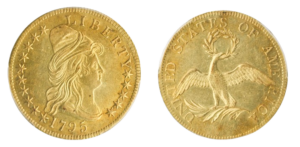
6. Investigate if rare coins that you might have were part of important discoveries.
Understanding the circumstances of a coin’s discovery can offer important guidance on how to know if you have a rare coin. Coins that were extracted from shipwrecks or unearthed as part of archaeological finds or historical excavations often carry an added allure for collectors. These discoveries not only contribute to the coin’s provenance but also provide a unique glimpse into the historical context and circumstances surrounding its burial or concealment.
The association with important discoveries can elevate the numismatic significance of a coin, making it more than a mere collectible. By delving into the stories behind these discoveries, collectors gain a deeper appreciation for the unique historical journey of a coin, enriching the overall experience of identifying and owning rare numismatic treasures.
A great example of a rare coin that provides a tangible link to history because of its discovery is this stunning piece, found on SS Central America:
1857-S $20 Liberty SSCA PCGS AU58
- Metal: Gold
- Year: 1857
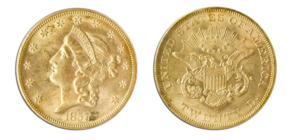
If you are fascinated by historic discoveries, read about the Gairsoppa wreck here.
7. Regionality plays a role in what makes a coin rare and valuable.
Regionality plays a pivotal role in determining the rarity and value of a coin within the numismatic world. The geographic origin of a coin can significantly influence its scarcity, as mints in different regions may produce varying quantities of a particular denomination. Furthermore, coins specific to certain regions may have limited distribution or bear regional symbols and designs that resonate strongly with collectors interested in the heritage of a specific geographic area.
When figuring out how to tell if you have a rare coin, you should consider regionality as a crucial aspect, recognizing that a coin’s origin contributes to its distinctive value. The regional context enhances the coin’s story, making it a cultural artifact that reflects the history and identity of a particular locale.
An exemplary regional coin steeped in history is the 1855 $50 Wass Molitor, minted during the height of the Gold Rush:
1855 $50 Wass Molitor NGC VF35 CAC
- Metal: Gold
- Year: 1855
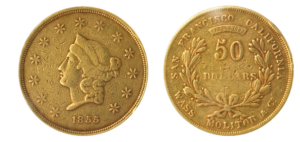
8. An indicator for how to know if a coin is rare is if it is exclusively part of a set.
An effective indicator for identifying rare coins is their exclusivity as part of a set, a key consideration for any rare coin checker. Whether issued for commemorative purposes, special occasions, or thematic collections, coins that can only be acquired as part of a set tend to be more sought after and rarer than standard issues.
The exclusivity of set-based coins is two-fold; it not only limits the individual coin’s availability but also enhances its desirability within the context of a comprehensive collection. Numismatists value the challenge of assembling complete sets, and the scarcity of specific coins within these sets adds a layer of difficulty to the pursuit.
9. Condition can offer valuable clues about rare coins you might have.
While the question “How old does a coin have to be to be rare?” often takes center stage, it’s essential to emphasize that age is just one consideration when it comes to rarity. Equally significant is the coin’s state of preservation, providing valuable insights into its history, wear, and overall scarcity.
Key indicators of a coin’s condition include the presence of luster, sharpness of details, and absence of scratches or discoloration. Numismatists carefully examine the surfaces, edges, and overall appearance of a coin to glean information about its rarity and historical significance.
Well-preserved coins, especially those in higher grades, are generally considered rarer and more desirable among collectors. Coins in exceptional condition often fetch higher prices in the market due to their scarcity. Understanding the language of coin grading and recognizing the significance of condition allows collectors to make informed decisions about the rarity and value of their coins.
10. Metal content and composition can be an effective coin rarity checker.
Examining the metal content and composition of a coin can also prove to be an effective strategy if you are looking for a way how to know if your coin is rare. The choice of metals used in minting coins can vary over time, and certain compositions may be specific to particular issues or historical periods.
Coins composed of precious metals, such as gold or silver, are often deemed rarer due to their inherent value. Historical coinage, especially from antiquity, might also boast unique compositions that reflect the economic and metallurgical practices of the time.
Understanding these metal details offers valuable insights into a coin’s scarcity. Numismatists meticulously study a coin’s metal content and composition, using this information as a valuable rarity checker.
Identifying rare coins: case study
What makes a 1971 2p coin rare?
The 1971 2p coin’s rarity stems from a design change when the Royal Mint transitioned from “New Pence” to “Two Pence.” A limited number of coins were mistakenly minted with the old inscription, making them highly sought after by collectors.
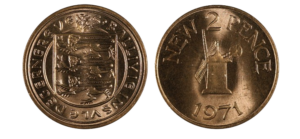
How can you tell if a 50p coin is rare?
To understand what makes a 50p coin rare, consider factors like mintage, design variations, and circulation history. An example of a rare 50p coin is the Kew Gardens 50p coin, minted in 2009 to commemorate the Royal Botanic Gardens, with a mintage of only 210,000.
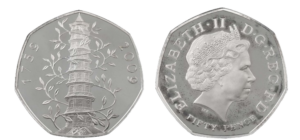
What makes a 1979 dollar coin rare?
The rarity of a 1979 dollar coin is generally determined by specific minting variations. For example, some 1979 Susan B. Anthony dollars were struck with a wide rim, creating the “near date” variety. This variety is considered more scarce compared to the standard version with a narrower rim.
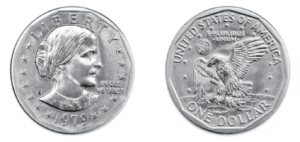
How do you know if you have a rare Sacagawea coin?
Everyone is familiar with the historical significance of the Sacagawea dollar, but the answer to the question “How to tell if a Sacagawea coin is rare?” lies beyond that. To ensure your coin is rare, check for minting errors, such as double strikes or planchet flaws, unique designs, or limited editions. The 2007 Sacagawea Dollar, with Edge Lettering, accidentally featuring a Presidential coin’s edge design, is exceptionally valuable due to its rarity, with only one known to exist.
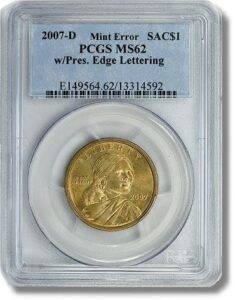
Photo by Coin Week
How do you tell if you have a rare Susan B Anthony coin?
Link to the coin image: https://www.pcgs.com/coinfacts/coin/1981-p-sba-1/9578
To determine what makes a Susan B. Anthony coin rare, inspect features like mint marks, design variations, and unusual characteristics. Certain years or mintages, such as those from 1981 and 1999, tend to be scarcer, impacting the coin’s rarity.
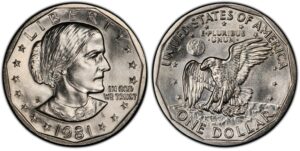
Photo by PCGS
What to do if you think you have a rare coin
- Research: Conduct thorough research on the coin, including its mint year, mint mark, and any unique characteristics.
- Consult experts: Seek advice from experienced numismatists who can provide valuable insights into the rarity of your coin. Blanchard’s team of experts is always available to provide you with information on how to check rare coins.
- Extend your collection: Add more rare coins to your collection with Blanchard’s rare coins checker’s guidance.
Want to read more? Subscribe to the Blanchard Newsletter and get our tales from the vault, our favorite stories from around the world and the latest tangible assets news delivered to your inbox weekly.







